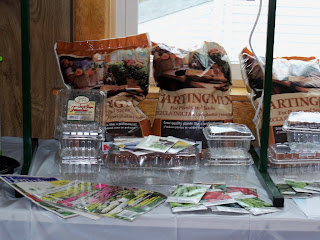Monday, March 18, 2013
Tuesday, March 12, 2013
Companion Planting
Over the past few years I have been experimenting with companion planting. I love the idea that certain plants benefit each other, and I especially love the plants that keep the "bad" bugs at bay. There are certain plants that shouldn't be planted together too! There are lots of great web sites with information about companion planting, and it's one of the things I like to look at while I'm planning my garden.
Certain flowers and herbs are a great way to help your garden succeed without chemicals. Did you know that basil repels mosquitos? One of my very favorite plants to put throughout my vegetable gardens is Marigolds. Not only do they detract aphids, but they look colorful in the early spring garden before the veggies are growing. If kept deadheaded throughout the summer, you'll still have marigolds in the fall when your harvest is just about done.
Nastursium is another easy grow flower that when planted with cucumbers and squash help deter the squash bugs, potato bugs and whiteflies. Another great thing about Nastursium is that the entire plant is edible. The pretty colorful flowers look amazing in a salad or floating on a nice cold summer soup. Nastursium are viney plants, and can take over if you let them, but they are great growing with your viney veggies!
This year I am planning to plant a Three Sister's Garden. A Native American tradition of planting corn, beans and squash together. The Iroquois believe corn, beans and squash are precious gifts from the Great Spirit, each watched over by one of three sisters spirits.
Certain flowers and herbs are a great way to help your garden succeed without chemicals. Did you know that basil repels mosquitos? One of my very favorite plants to put throughout my vegetable gardens is Marigolds. Not only do they detract aphids, but they look colorful in the early spring garden before the veggies are growing. If kept deadheaded throughout the summer, you'll still have marigolds in the fall when your harvest is just about done.
Nastursium is another easy grow flower that when planted with cucumbers and squash help deter the squash bugs, potato bugs and whiteflies. Another great thing about Nastursium is that the entire plant is edible. The pretty colorful flowers look amazing in a salad or floating on a nice cold summer soup. Nastursium are viney plants, and can take over if you let them, but they are great growing with your viney veggies!
This year I am planning to plant a Three Sister's Garden. A Native American tradition of planting corn, beans and squash together. The Iroquois believe corn, beans and squash are precious gifts from the Great Spirit, each watched over by one of three sisters spirits.
Corn provides a natural pole for bean vines to climb. Beans fix nitrogen on their roots, improving the overall fertility of the plot by providing nitrogen to the following years corn. Bean vines also help stabilize the corn plants, making them less vulnerable to blowing over in the wind. Shallow-rooted squash vines become a living mulch, shading emerging weeds and preventing soil moisture from evaporating, thereby improving the overall crops chances of survival in dry years. Spiny squash plants also help discourage predators from approaching the corn and beans. The large amount of crop residue from this planting combination can be incorporated back into the soil at the end of the season, to build up the organic matter and improve its structure.
I planted a Three Sister's Garden several years ago, and it was wonderful! The past few years I didn't really have the space, but last year Vito made me a nice big garden in the back, and it's just waiting for the three sisters!
Here are a few of some good sites to read about companion planting:
http://www.gardentoad.com/companionplants.html
http://www.gardentoad.com/companionplants.html
http://www.sustainable-gardening-tips.com/companion-planting-vegetable-list.html
Happy Gardening!
Mary
Happy Gardening!
Mary
Friday, March 8, 2013
Thursday, March 7, 2013
Getting Ready

Last year I started some of my seeds in last year's left over plastic 6 pack containers that seedlings from the previous year had come in that I steralized, and many in the cardboard like seed starters. Then I one day I spotted one of the little plastic boxes my grape tomatoes and spinach came in, and thought to myself "that is a mini green house!" They were perfect. In the past I have used egg cartons, but found those got mildewy too fast, but those lovely little plastic boxes are perfect.
So far I've started corn, catnip, spaghetti squash, eggplant, and some peppers. Now if the weather would just cooperate I'm ready to start cleaning the yard. Unfortunately, this week's forecast doesn't seem to be cooperating with my desires. Oh well, there's still plenty we can do now in the planning stages. If you haven't already read Mommy Melissa's post on garden planning, check it out, she shared a great link!
Happy gardening!
Mary
Subscribe to:
Comments (Atom)



